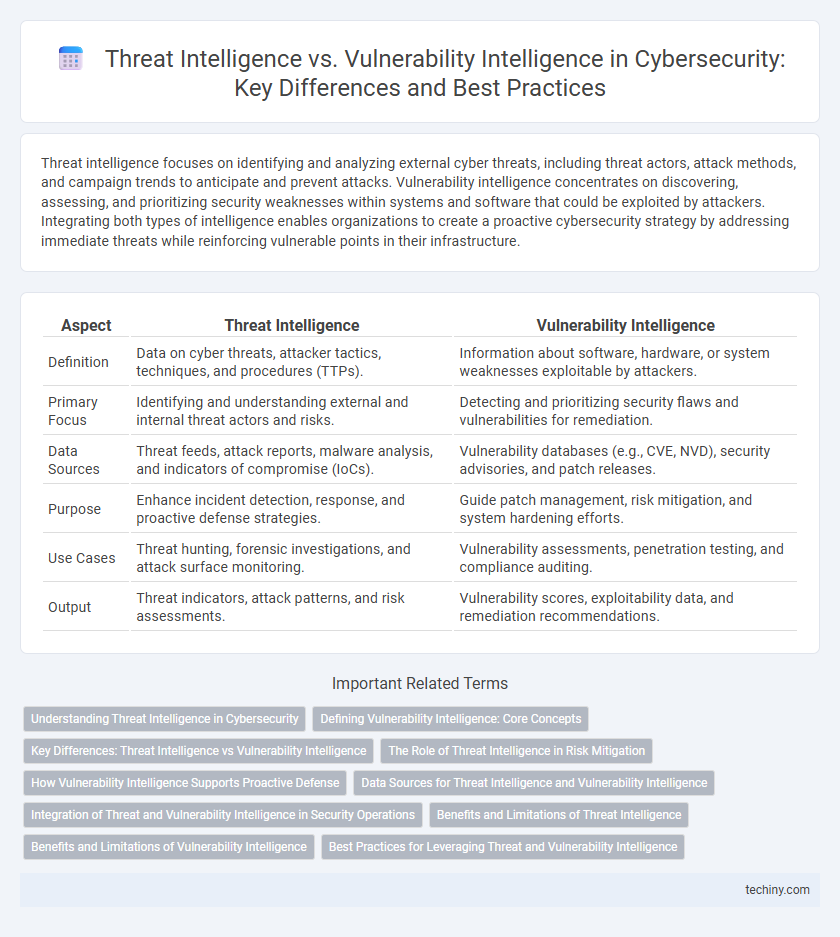Threat intelligence focuses on identifying and analyzing external cyber threats, including threat actors, attack methods, and campaign trends to anticipate and prevent attacks. Vulnerability intelligence concentrates on discovering, assessing, and prioritizing security weaknesses within systems and software that could be exploited by attackers. Integrating both types of intelligence enables organizations to create a proactive cybersecurity strategy by addressing immediate threats while reinforcing vulnerable points in their infrastructure.
Table of Comparison
| Aspect | Threat Intelligence | Vulnerability Intelligence |
|---|---|---|
| Definition | Data on cyber threats, attacker tactics, techniques, and procedures (TTPs). | Information about software, hardware, or system weaknesses exploitable by attackers. |
| Primary Focus | Identifying and understanding external and internal threat actors and risks. | Detecting and prioritizing security flaws and vulnerabilities for remediation. |
| Data Sources | Threat feeds, attack reports, malware analysis, and indicators of compromise (IoCs). | Vulnerability databases (e.g., CVE, NVD), security advisories, and patch releases. |
| Purpose | Enhance incident detection, response, and proactive defense strategies. | Guide patch management, risk mitigation, and system hardening efforts. |
| Use Cases | Threat hunting, forensic investigations, and attack surface monitoring. | Vulnerability assessments, penetration testing, and compliance auditing. |
| Output | Threat indicators, attack patterns, and risk assessments. | Vulnerability scores, exploitability data, and remediation recommendations. |
Understanding Threat Intelligence in Cybersecurity
Threat intelligence in cybersecurity involves the collection and analysis of data about current and emerging cyber threats, including actor tactics, techniques, and procedures (TTPs), to anticipate and mitigate attacks. It provides actionable insights on threat actors, indicators of compromise (IOCs), and attack patterns, enabling organizations to prioritize defenses and respond proactively. Unlike vulnerability intelligence, which focuses on identifying and assessing weaknesses in systems, threat intelligence encompasses a broader scope of external and internal adversarial behaviors targeting various assets.
Defining Vulnerability Intelligence: Core Concepts
Vulnerability intelligence involves the systematic identification, analysis, and prioritization of weaknesses in software, hardware, and network systems that could be exploited by cyber attackers. It focuses on gathering detailed data about vulnerabilities, including their severity scores, exploit availability, and patch status, to inform proactive defense strategies. Unlike threat intelligence, which centers on adversary tactics and threat actors, vulnerability intelligence emphasizes understanding system flaws to mitigate risks before exploitation.
Key Differences: Threat Intelligence vs Vulnerability Intelligence
Threat intelligence provides actionable insights on potential cyber adversaries and their tactics, techniques, and procedures (TTPs), enabling proactive defense against attacks. Vulnerability intelligence focuses on identifying, assessing, and prioritizing security weaknesses within systems and software to mitigate exploitation risks. Together, these intelligence types form a comprehensive defense strategy by combining attacker behavior analysis with system flaw management.
The Role of Threat Intelligence in Risk Mitigation
Threat intelligence plays a critical role in risk mitigation by providing actionable insights into emerging cyber threats, enabling organizations to anticipate and defend against potential attacks. Unlike vulnerability intelligence, which identifies weaknesses within systems, threat intelligence analyzes attacker tactics, techniques, and procedures (TTPs) to proactively address threats before exploitation. Integrating threat intelligence into cybersecurity strategies enhances incident response, reduces exposure to cyber risks, and supports informed decision-making for security investments.
How Vulnerability Intelligence Supports Proactive Defense
Vulnerability intelligence provides detailed insights into software weaknesses, enabling security teams to prioritize patches and remediate risks before exploitation occurs. By integrating real-time vulnerability data with existing security infrastructure, organizations strengthen their proactive defense strategies against emerging cyber threats. This targeted approach reduces the attack surface and improves response times, enhancing overall cybersecurity posture.
Data Sources for Threat Intelligence and Vulnerability Intelligence
Threat intelligence relies on diverse data sources such as open-source intelligence (OSINT), dark web monitoring, threat feeds from security vendors, and incident reports to identify emerging cyber threats, attack patterns, and threat actor tactics. Vulnerability intelligence gathers information from software vendor advisories, vulnerability databases like CVE and NVD, penetration testing results, and configuration audits to pinpoint security weaknesses and potential exploitation points within systems. Effective cybersecurity strategies integrate both data sets, enabling proactive defense by correlating threat actor behaviors with specific vulnerabilities to mitigate risks before exploitation occurs.
Integration of Threat and Vulnerability Intelligence in Security Operations
Integrating threat intelligence with vulnerability intelligence enhances security operations by providing a comprehensive view of both external threats and internal weaknesses. This synergy allows security teams to prioritize remediation efforts based on real-time threat data and exploitability of vulnerabilities. Effective integration improves incident response speed and reduces the attack surface by aligning patch management with emerging threat landscapes.
Benefits and Limitations of Threat Intelligence
Threat intelligence provides actionable insights into emerging cyber threats, enabling organizations to proactively defend against attacks by understanding attacker tactics, techniques, and procedures (TTPs). Its benefits include enhancing incident response, improving threat detection, and supporting strategic security planning, though limitations arise from potential data overload, false positives, and the need for continuous updates to remain relevant. While threat intelligence offers external perspectives on malicious actors, effectiveness depends on integration with internal security practices and comprehensive vulnerability management.
Benefits and Limitations of Vulnerability Intelligence
Vulnerability intelligence provides detailed insights into software weaknesses and configuration flaws, enabling organizations to prioritize patch management and reduce the risk of exploitation. Its benefits include timely identification of critical vulnerabilities and support for proactive defense strategies, but limitations arise from incomplete data coverage and potential delays in vulnerability disclosure. Unlike threat intelligence, which focuses on attacker tactics and indicators, vulnerability intelligence requires continuous updates and expert analysis to effectively mitigate emerging threats.
Best Practices for Leveraging Threat and Vulnerability Intelligence
Effective cybersecurity strategies prioritize integrating threat intelligence with vulnerability intelligence to enhance risk assessment accuracy and response speed. Organizations should continuously collect and analyze data from diverse sources, applying contextual insights to prioritize vulnerabilities based on exploitability and potential impact. Leveraging automated tools and threat intelligence platforms enables real-time correlation of threats and vulnerabilities, empowering security teams to implement proactive defense measures and reduce attack surface exposure.
threat intelligence vs vulnerability intelligence Infographic

 techiny.com
techiny.com